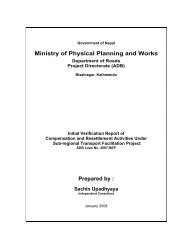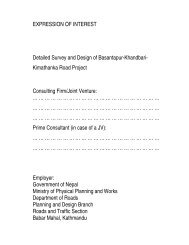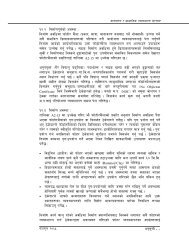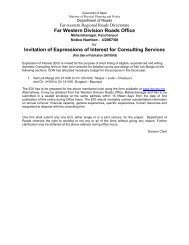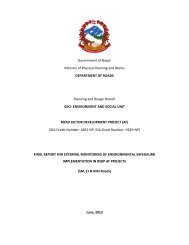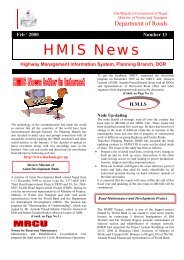Environmental & Social Management Framework - About ...
Environmental & Social Management Framework - About ...
Environmental & Social Management Framework - About ...
You also want an ePaper? Increase the reach of your titles
YUMPU automatically turns print PDFs into web optimized ePapers that Google loves.
<strong>Environmental</strong> and <strong>Social</strong> <strong>Management</strong> <strong>Framework</strong>All areas susceptible to erosion, such as cut and fill areas, shall be protected byeither temporary or permanent drainage works. Measures should be taken toprevent ponding of surface water and scouring of slopes. Newly eroded channelsshould be backfilled and restored to natural contours. Where crossing unstableterrain is unavoidable, minimize the road width for the section affected to reducedisruption to the slope. Pay special attention to drainage and leave a temporaryroad surface until a stable condition is achieved.e. Avoiding Hazards due to Unsafe Spoil DisposalConstruction work implies that extensive excavations will be carried out toprepare for the RoW. Spoil should be well managed with appropriate terracing atappropriate locations. Spoil should be managed adopting the following principlesand methodologies:• Preventive Measures:Careful selection of the road centre line by adjustment up or down the slopeshould aim to achieve balance between cut and fill within a reasonable haulagelength. Alignments on ridges are considered to be best alignment avoidingexcessive excavation. Other suitable options include to balance cut and fill forminimizing spoil generation, and to use phased construction techniques.• Mitigative Measures:- Wherever possible, use surplus spoil to fill eroded gullies and depressedareas.- If feasible, spoil material may be disposed in abandoned quarries andborrow pits as means to help restore original contours.- It is advised to use the excavated materials for reclaiming the degradedland in near vicinity in consultation with local communities on theirpreferences.- Never dispose spoil on fragile slopes, flood ways, wetland, farmland,forest areas, natural drainage path, religious and culturally sensitive sites,wetlands, canals and other infrastructures.- Acidic and saline spoil shall not be spread onto agriculture land.- Never dispose spoils on areas that will create inconvenience to the localcommunity or it will deprive the livelihood of people.- Spoil material may be discharged to a landfill that is constructed using aseries of small spoil benches to prevent slope overloading;- During disposal, place the spoil in layers of about 15 cm and compacteach layer at optimum moisture content,- After the disposal, the site should be landscaped, provided with properdrainage, plant with vegetation, and provide adequate protection againsterosion and scouring.- Spoil should not be disposed in rivers, lakes and water bodies;- Exposed areas should be planted with suitable vegetation at the earliestopportunity following the GESU/DoR Manual on ’Vegetation Structures forStabilizing Highway Slopes- A Manual for Nepal’.• Compensatory Measures:- Provide adequate compensation to land and property damaged by spoilstorage and disposal;- Use well-covered spoil to build community facilities like playground orpark by reclaiming land in public area;- Use spoil in local road net and embankment construction works.Chapter 6-6 April 2007



![j:6 ]zg cfof ]hgf](https://img.yumpu.com/51286794/1/190x245/j6-zg-cfof-hgf.jpg?quality=85)

![x'nfsL /fhdfu { cfof ]hgf](https://img.yumpu.com/50581959/1/190x245/xnfsl-fhdfu-cfof-hgf.jpg?quality=85)
